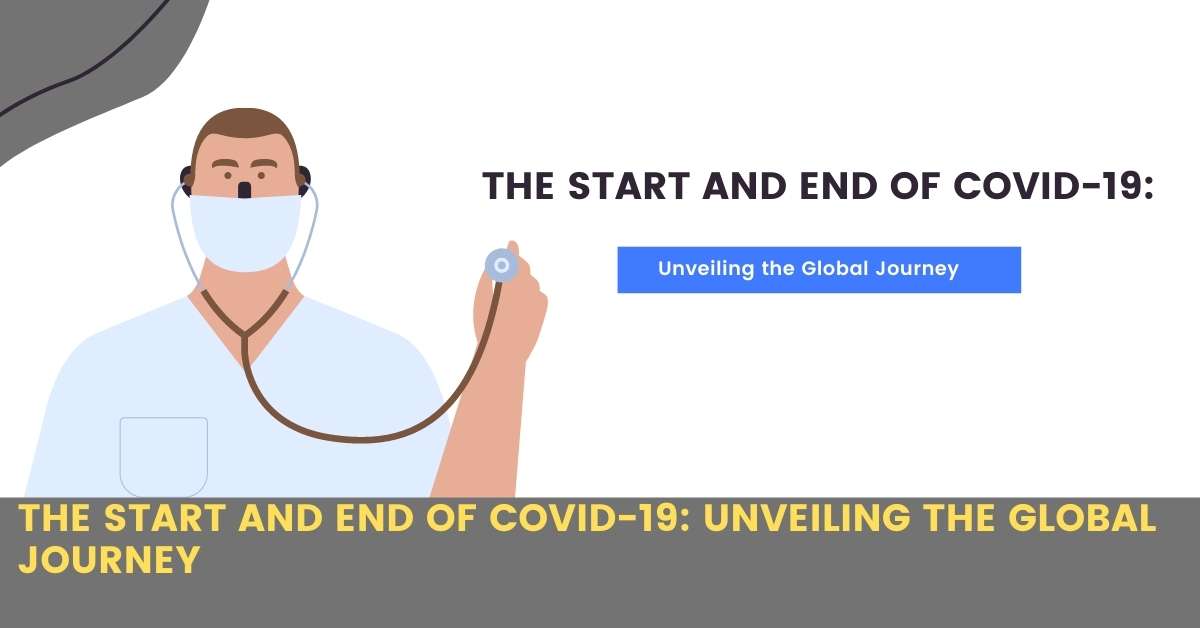
The COVID-19 pandemic has left an indelible mark on the world, disrupting lives and societies on an unprecedented scale. In this article, we delve into the intriguing tale of the start and end of COVID-19, tracing its origins, the global impact it wrought, and the ongoing efforts to regain control and restore normalcy.
Understanding COVID-19
What is COVID-19?
COVID-19, officially known as Coronavirus Disease 2019, is an infectious illness caused by the novel coronavirus SARS-CoV-2. It made its initial appearance in late 2019 and swiftly traversed the globe, compelling the World Health Organization (WHO) to declare it a pandemic.
How does COVID-19 spread?
COVID-19 primarily spreads through respiratory droplets released when an infected individual coughs, sneezes, or talks. It can also transmit by touching contaminated surfaces and subsequently touching the face. Close contact with an infected person poses the highest risk of transmission.
Symptoms of COVID-19
While fever, cough, and difficulty breathing are common symptoms of COVID-19, the virus exhibits a spectrum of manifestations. Fatigue, loss of taste or smell, sore throat, and body aches are among the varied symptoms. In severe cases, the infection can lead to acute respiratory distress and other complications.
The Initial Outbreak
Wuhan, China: Ground Zero
The first recorded cases of COVID-19 emerged in Wuhan, China, in late December 2019. The city swiftly became the epicenter of the outbreak, grappling with a significant number of cases and fatalities. The exact origin of the virus remains a subject of investigation, though it is believed to have emanated from a seafood market that also traded live animals.
Rapid Global Spread
Within a matter of weeks, COVID-19 broke free from Wuhan’s confines, infiltrating other regions of China and permeating the international landscape. Global connectivity and widespread travel facilitated the virus’s rapid transmission, with major cities transforming into hotbeds of contagion. The pandemic’s velocity and scale were unprecedented.
Initial Measures and Response
Governments and health organizations worldwide swiftly implemented measures to contain the spread of the virus. Travel restrictions, quarantine protocols, and public health campaigns emphasizing hand hygiene and social distancing were enacted. However, the virus had already infiltrated numerous countries, rendering containment efforts challenging.
Global Impact
Health Systems Overwhelmed
The surge in COVID-19 cases placed an enormous strain on healthcare systems worldwide. Hospitals grappled with shortages of beds, medical equipment, and healthcare workers. Intensive care units teetered on the brink of collapse, while healthcare professionals toiled relentlessly to save lives. The crisis underscored the pressing need for effective containment measures and improved preparedness for future pandemics.
Economic Consequences
The pandemic precipitated a severe global economic downturn, leaving businesses shuttered and triggering widespread job losses and economic instability. Industries such as travel, hospitality, and retail were dealt a severe blow. Governments responded with diverse stimulus packages and support measures, yet the road to economic recovery has proven protracted and uneven, varying across sectors and countries.
Social and Psychological Impact
Social interactions were disrupted, and feelings of isolation, anxiety, and fear pervaded societies. Lockdowns and restrictions on gatherings exacted a toll on mental health, with individuals grappling with the loss of loved ones and the uncertainty of the future. The pandemic underscored the importance of bolstering mental health support systems and fostering resilience during times of crisis.
Efforts to Control the Virus
Lockdowns and Social Distancing
To curb the virus’s spread, countries implemented stringent lockdowns and enforced social distancing measures. Citizens were urged to stay home, avoid gatherings, and maintain physical distance from others. Though challenging, these measures played a pivotal role in slowing transmission rates and granting healthcare systems crucial breathing space.
Testing, Contact Tracing, and Vaccination
Testing for COVID-19 emerged as a cornerstone strategy in identifying and isolating infected individuals. Contact tracing initiatives helped identify and notify individuals who came into contact with confirmed cases. The development and widespread distribution of vaccines have heralded a ray of hope, with mass vaccination campaigns aiming to achieve herd immunity and diminish the severity of the illness.
The Road to Recovery
Development of Vaccines
Scientific communities and pharmaceutical companies dedicated their efforts to developing safe and effective COVID-19 vaccines. The unprecedented speed at which vaccines were developed led to several receiving emergency use authorization. Vaccination programs commenced worldwide, initially targeting vulnerable populations and gradually expanding to cover broader age groups.
Easing Restrictions
With rising vaccination rates and declining case numbers, countries cautiously began easing restrictions and reopening their economies. A phased approach was adopted, allowing businesses, schools, and public spaces to resume operations while adhering to specific precautions. However, remaining vigilant and adhering to public health guidelines remained paramount to preventing a resurgence of the virus.
The Rise of Variants
The emergence of new variants posed fresh challenges to control efforts. Variants such as the Delta variant demonstrated heightened transmissibility, fueling localized outbreaks and necessitating additional measures like targeted lockdowns and accelerated vaccination campaigns. Continuous surveillance and genomic sequencing enabled authorities to monitor and track the virus’s evolution effectively.
Conclusion
The start and end of COVID-19 have unveiled a saga of global proportions. Originating in Wuhan, China, the virus rapidly spread worldwide, overwhelming healthcare systems and causing economic and social upheaval. Stringent measures such as lockdowns, testing, contact tracing, and vaccination campaigns have played crucial roles in mitigating the impact. Yet, the battle against COVID-19 persists, underscoring the imperative of sustained vigilance and global cooperation.
